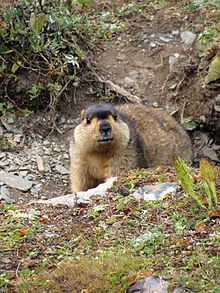Himalayan marmot
| Himalayan marmot | |
|---|---|
 | |
| Himalayan marmot at Tshophu Lake, Bhutan at 4,100 m (13,500 ft) altitude. | |
| Conservation status | |
| Scientific classification | |
| Kingdom: | Animalia |
| Phylum: | Chordata |
| Class: | Mammalia |
| Order: | Rodentia |
| Family: | Sciuridae |
| Genus: | Marmota |
| Subgenus: | Marmota |
| Species: | M. himalayana |
| Binomial name | |
| Marmota himalayana (Hodgson, 1841) | |
The Himalayan marmot (Marmota himalayana) is a marmot found in alpine grasslands throughout the Himalayas and on the Tibetan Plateau at elevation from 3,500 to 5,200 m (11,500 to 17,100 ft). It lives in colonies and excavates deep burrows that colony members share during hibernation.[1]
It is about the size of a large housecat. It is closely related to the woodchuck, the hoary marmot and the yellow-bellied marmot. It has a dark chocolate-brown coat with contrasting yellow patches on its face and chest.
Gallery
In culture
The French ethnologist Michel Peissel claimed that the story of 'gold-digging ants' reported by the Greek historian Herodotus (5th century BC), was founded on the golden Himalayan marmot of the Deosai plateau and the habit of local tribes such as the Minaro to collect the gold dust excavated from their burrows.[2]
References
- ↑ 1.0 1.1 Molur, S. & Shreshtha, T. K. (2008). "Marmota himalayana". IUCN Red List of Threatened Species. Version 2014.2. International Union for Conservation of Nature.
- ↑ Peissel, M. (1984). "The Ants' Gold: The Discovery of the Greek El Dorado in the Himalayas". Harvill Press. ISBN 978-0-00-272514-9.
- Thorington, R. W. Jr. and R. S. Hoffman. 2005. Family Sciuridae. Pp.754–818 in D. E. Wilson and D. M. Reeder (eds.) Mammal Species of the World. A Taxonomic and Geographic Reference. Johns Hopkins University Press, Baltimore.
External links
| Wikimedia Commons has media related to Marmota himalayana. |



